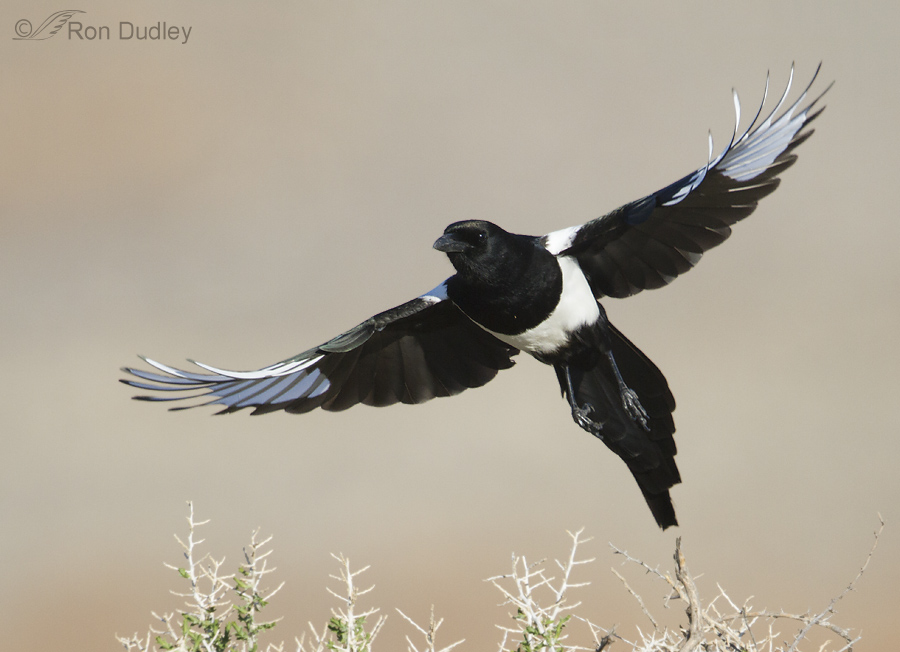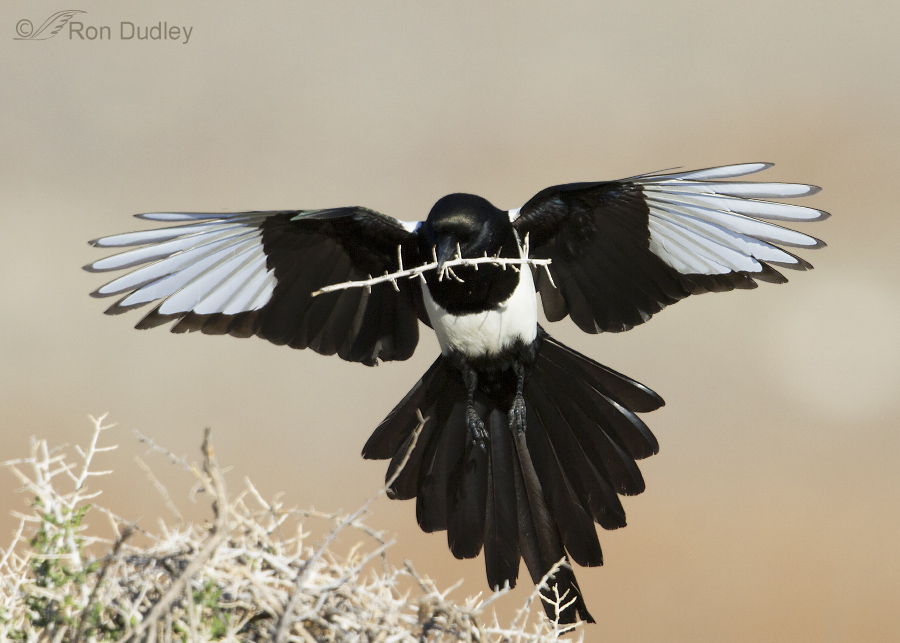Photographing birds as they take off is tricky but with a little luck and perseverance it can be done. Landing shots are much more difficult and often require creative technique.

1/2500, f/6.3, ISO 500, Canon 7D, 500 f/4 II, 1.4 tc, canvas added for composition, not baited, set up or called in
This image was taken three days ago as this Black-billed Magpie took off from its nest bush after delivering nesting material. I have a few other shots similar to this and I like them a lot but they always remind me that there’s something missing. I want to get the tail fully flared because I really like its shape when it’s completely spread out. That’s much more likely to happen when the bird is landing than it is during take-off but landing shots are very difficult for me to pull off, especially while shooting from my vehicle.
To avoid disturbing these birds at the nest I photograph them from my pickup parked on a road which means that my window opening severely restricts the left to right angle that I can shoot. So when I notice an incoming magpie by the time I can see it through my viewfinder I usually don’t have time to lock focus on the bird before it lands. Focus lock is made even more difficult because there’s a mountain in the background instead of featureless sky.
So occasionally out of severe frustration I impulsively try a Hail Mary tactic…
 1/2500, f/6.3, ISO 500, Canon 7D, 500 f/4 II, 1.4 tc, twig tip removed, not baited, set up or called in
1/2500, f/6.3, ISO 500, Canon 7D, 500 f/4 II, 1.4 tc, twig tip removed, not baited, set up or called in
I call it “hip-shooting”, (definition – an action or reaction that is quick and often reckless, as in the old west during gunfights when participants drew from a holster on the hip and fired quickly without aiming). Without taking the time to locate the bird in my viewfinder as it approaches I simply point my very long lens in the direction I think it will land and fire off a burst as it comes in to land on a spot on the bush that I can’t predict. This is very difficult to do at long focal lengths (with the crop factor of the 7D and the teleconverter I’m shooting at 1120 mm) because you have very little wiggle room to get the bird in frame (think of trying to light up a bird in flight with a very narrow-beam flashlight when you can’t see the light). When I try this method, probably over 95% of the time I’ve either missed the bird completely or I’ve clipped body parts.
To complicate matters even further you not only need to get the entire bird in frame, you must get it in sharp focus. This requires pre-focusing which means you have to anticipate how far the bird will be away from you when you fire the burst.
So for this shot I pre-focused on some twigs (out of frame) that I judged to be about a foot behind the nest, waited for the bird to come in and fired a burst as I looked down the barrel of my lens instead of through the viewfinder. This time I miraculously got four shots without clipping any body parts. Since I had pre-focused they were naturally of varying sharpness as the bird came toward me. There’s no light in the eye, I really don’t like the out of focus blob (top of nest) at lower left and the image is tight at the bottom but I got the tail shape I was after, a nice wing spread and nesting material in the beak. Maybe next time I’ll get a similar shot without the blurry nest in the frame.
Hip-shooting is truly a long-shot technique but it has some potential for success. Unlike film, pixels are cheap so I’m sure I’ll keep trying.
Ron
Note: I realize that many readers aren’t particularly interested in technique – only the results. But there’s enough photographers who see my posts that occasionally I can’t resist a little photo-geekiness…


Ah…the Hail Mary technique.It has universal application! Personally, I like the twigs in the shot;this tells us exactly what’s going on.Also like the bird’s right foot -ready to grip-and-steady.
I’d give you pretty high marks on this one, sir.
Agreed, Diane – the occasional Hail Mary can be productive if not overused. I’d like the twigs better if they were sharper…
Wow. The technique discussions go over my head often BUT, and it is a bit but, with luck some of it will sink in to the porridge in my head and be allow me to extract it when/if it is needed.
Education is never wasted – particularly when it is wrapped in eye candy.
You’ve got anything BUT porridge in your head, Elephant’s Child. Thank you.
I love the technique discussion! I’m kind of a statistics geek, especially on the low-probability end of things. The method you describe is a great example of how to make the odds work in your favor.
“You miss 100% of the shots you don’t take.” – Wayne Gretzky
Delighted to hear you like discussion of technique, Tim. I’ve always loved that Gretzky quote and have actually used it here before. A perfect fit for this discussion.
Another great technique! I’ve been experimenting with “rear focus” to lock onto my pre-focused point and it seems to work better than allowing the auto focus to “guess” where I want it to be. Success rate of useable images is probably about the same. I’ll keep practicing.
In the meantime, I’ll continue to enjoy your pixels of perfection!
Thanks again, Ron, for all the inspiration!
Wally, all we can do is “keep practicing” with our various techniques and hope they pan out occasionally. It’s fun when it works out, isn’t it?
Thanks.
I was just trying out that technique yesterday. Photographers who shoot races…people or cars…often use that method of shooting. They focus ona spot where the movement will pass by and then burst. Or they pan in advance of the moving subject and then burst. I need a lot mor epractice in this method especaily before the hummingbirds return!!
Ellen, interesting to learn of the universal application of the technique. It makes particular sense in that application. At least racing cars and people often move on a track where their future position can be anticipated to some degree – birds are so blasted unpredictable…
Wow! You did it! Congrats! Thanks for sharing your incredible shots Ron!
Charlotte
Thank you, Charlotte.
Since I’m interested in learning about birds and photographing them, I enjoy reading how you might have captured a shot … and it’s nice to know that even a pro like you will “shoot from the hip.”
Patricia, Though I take my photography very seriously I’m certainly not a pro. I’m just an amateur who puts a lot of time and effort into a hobby that I love. Thanks for the vote of confidence though and I’m glad to hear you enjoy it when I go into technique.
Ah, what a difference today’s cameras make on allowing us to shoot any way we want. With film, I always would think of the cost of development, but now with digital it is so… much more fun, just need to take the time at the computer to delete!
And, what satisfaction is gendered when one does this to get a shot like these!! Great job.
Been away for a week, need to catch up, but always check into your photos!
Yes, those of us who remember film realize what a difference digital has made for us. Thank you, Dick.
I really appreciate your sharing the techniques you use to capture these wonderful images.
Thanks for saying that, Ned. I know this technique stuff isn’t everyone’s cup of tea.